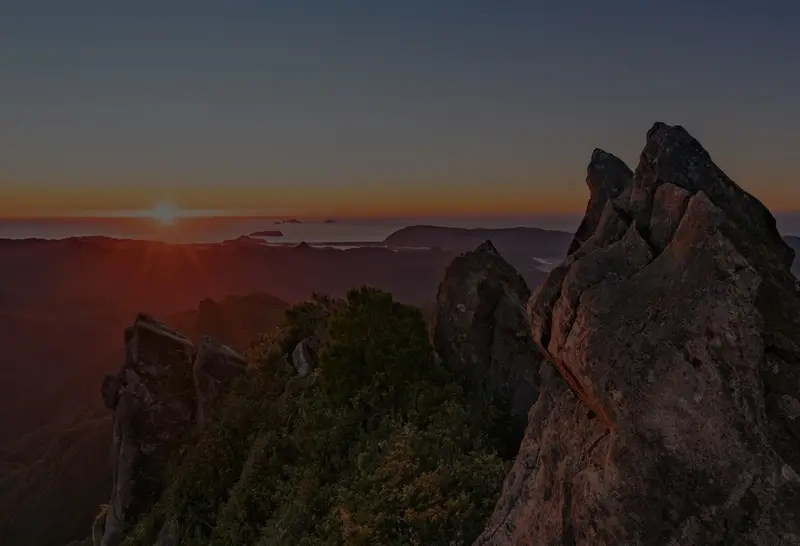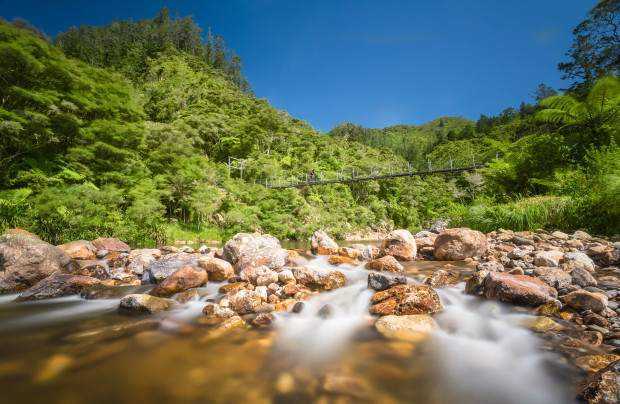
While many visit the famous Cathedral Cove and Hot Water Beach, the volcanic coastline of The Coromandel shelters many hidden caves, bays and secret places. The presence of powerful underground forces from the past is visible in and around the Mercury Bay and off the eastern coast, along the high white cliffs and the strangely sculpted rock formations. The only way to get there is out on the water, and it's the best way to interpret the clues left by ancient geothermal activity. Not only does the approach by sea give you a different perspective on the beaches where Kiwis love to holiday, it also introduces you to the stories of coastal life and the people who have made this place their home over the years.
Te Whanganui-O-Hei Marine Reserve
The waters off Cathedral Cove are protected, and teeming with wildlife. Fishing is great in these waters, but the boats are kept well away, and many marine creatures make their home inside the sanctuary boundaries. Snorkeling in Gemstone Bay gives you a window into the amazing underwater world in safe and clear blue waters, with buoys to rest on, and pictures of the many marine species sharing the water with you. It's a great place to learn to dive, for calm waters close to shore and intriguing diving companions.
Tip: Hire a snorkel or take a dive tour from Hahei

Venture by boat into Orua Sea cave
Begin your maritime adventure by kayak or small boat, directly from the beach in Hahei or from the wharf in Whitianga. Heading east from Hahei, almost to Hot Water Beach, you will find Aotearoa New Zealand’s second largest sea cave. Spectacular in its symmetry, once you navigate the narrow entrance the bell-shaped cavern opens above and is mirrored in the dark waters below. As your skipper expertly drifts so close to the multi-coloured cave walls, it is tempting to try out the echo effect. Great for singers!
Sculpted rock formations in Champagne Bay
It is easily recognizable by the upended champagne saucer, and the waters surge around the surrounding rocky islets. The constant erosion by the sea results in an ever-changing environment. Sea caves become arches and eventually pinnacle rocks such as these, standing in the shallows as the sea continues its work.
Tip: The waters near here are sometimes called “the washing machine”
Sneak into the Wai Ora Ana Blowhole
Only your skipper knows how and when to nimbly enter the hidden sea cave in to this ancient vent, the mighty rock cylinder of Wai Ora Ana. When the sea and tide conditions are right you slip into the heart of the blowhole to gaze up 25 metres to the open sky and the rim of the blowhole ringed with pōhutukawa. One of the most dramatic features of this strange coast, and some amazing stories to be told.

Set off for the The Aldermen Islands
The distinctive rocky profiles lying about 20km off the coast of Tairua and Pauanui can be seen along the east coast of The Coromandel. The islands are an important nature reserve and wildlife sanctuary. A favourite with divers and fishermen for the amazing wildlife and magical volcanic forms above and below the water, the Aldermen are known as one of the best open water dive sites in New Zealand. The waters are clear, and the steep rocky forms rise up to 200 metres from the sandy sea bed, offering a spectacular "skyscraper" experience to divers navigating the spires. Some visitors describe the feeling of being in Jurassic Park.
Tip: Take a fishing or diving trip from Whitianga or Tairua
Cast away on a Pacific island paradise
Most of the islands off the east coast of The Coromandel are uninhabited nature reserves, home to endangered species like tusked wētā, nesting sites for seabirds, and favourites for diving and fishing. But there is an island, a 15-minute water taxi ride from Tairua, where you can maroon yourself in comfort. Slipper Island has beachside glamping, chalets, and a lodge. As one of New Zealand’s few privately-owned islands, you, plus your mates and family, can rent the island for a night for less than the cost of a city hotel. Forget Bali, the water here is turquoise, the beaches are deserted, and island life is sure good for your soul.
Paddle to the heart of Whenuakura Wildlife Sanctuary
Whangamatā is home to one of New Zealand’s most beautiful coastal attractions. Tantalisingly close to the well-known surf beach, Whenuakura Wildlife Sanctuary, (often referred to as Donut Island), was a local secret. This has changed in recent years as this pacific treasure is quickly becoming a ‘must do’ New Zealand adventure. The island is a collapsed volcanic blowhole and hides a magical azure lagoon in its centre. The only way in is via a narrow 10metre-high sea cave invisible from the beach
Over many years local families and regular holiday visitors have had a deep connection with the Islands, the ancestral home of Ngā Marama the first Polynesians to occupy the Whangamatā area. Whenuakura is a spiritual place to local iwi and many Whangamatā locals. As guardians of the islands, locals encourage visitors to treat the islands with respect to preserve their future, by going with a guide, staying on the water and taking only photos. Travelling with a guide is the best (and safest) was to access this special place, to hear the stories of the islands and the efforts to protect them. A portion of the fee from all tours goes to the trust whose ultimate aim is return Whenuakura to its pristine predator-free state and reintroduce tuatara.












